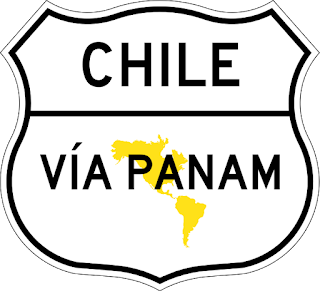 |
Mural on Garnet Avenue in San Diego
(Flickr user Nathan Rupert/CC)
|
The old Highway 101 was realigned several times to accommodate a growing San Diego and to address challenges with the terrain. The original route, when the highway opened, followed the coast and continued North on Cass St. passing Mission Beach, The route continued North into La Jolla. Leaving La Jolla motorist had to deal with two steep and narrow grades, "Biological Grade" and Torrey Pines Grade.
Speed be damned! We are going for interesting! We follow the original Highway 101 as it heads west on Garnet to the intersection of Cass. We are now in the neighborhood of Pacific Beach, where the road turns North.
 |
| Garnet Avenue (Flickr user Chris Lee/CC) |
 |
| Another View Of Garnet Avenue (Flickr user Gary J. Wood/CC) |
Garnet and Cass is our stop for today's travels. There is more to see at Pacific Beach and we will be lingering. Subscribe to this blog for my next post from San Diego, there is a form at the bottom of this post, it's free and I will not share your email with anyone else..
Playlist Addition
Battalion Of Saints
In our last post from San Diego we talked about San Diego's first wave punk band The Zeroes, dubbed the "Mexican Ramones", Like so much of the first wave of punk by 1981 The Zeroes had broken up.
Punk did not die, as any music fan knows. In the suburbs of the United States, punk rock records were collected and some of the fashion's were adopted by suburban kids who could afford to haunt obscure import record stores.
Few places are suburban as California. That suburban scene, along with several other suburban and urban areas in America's larger cities, spawned a new wave of punk rock music called hardcore that adapted faster more minimal song structures with an often strong melodic style. Punk rock had grown from a disaffected mid-twenties artsy movement to a a hormonal fan base of rowdy adolescents, mostly boys.
California was a hotbed of the new new hard core style contributing bands all up and down the coast. From San Francisco, the Dead Kennedy's were one of the few first wave punk bands that made the transition into hardcore. In Los Angeles, X, Black Flag, the Circle Jerks and Suicidal Tendencies dominated the scene. Orange County gave us TSOL, The Dickies, and Social Distortion.
In San Diego, the big band in the hardcore world was Battalion Of Saints. The were founded in 1980 and originally were named the Nurons. Battalion Of Saints consisted of singer George Anthony and guitarist Chris Smith. They were joined by bass player Dennis Frame and Ted Olson on drums;
 |
| Battalion Of Saints Flyer 1985 (?) (Flickr user JB Kopp/CC) |
In their defense, the punk scene could be pretty violent and self destructive. Fights, drinking and hard drug use happened. But it was far from universal among punk fans. Hardcore also did a lot to establish the DIY ethic, and fostered political awareness, even if the perception was largely negative about the state of the worlds politics.
The Bats, as Battalion Of Saints were called by fans, played the punk rock loser image to the hilt. they were all about the drugs drinking and fighting-and the politics. Some of their songs featured surprisingly strong lyrics.
Their music was clean and hard with critics noting some heavy metal guitar riffs from Chris Smith that were unique to the punk scene at that time. The band played extensively in Southern California and the Bay area and played a toured to Missouri and Utah among other places. But San Diego was home.
San Diego had a small and suffering hardcore scene. In 1983, the 8th issue of the fanzine Ripper featured an interview with the band talking about the punk rock scene in San Diego at the time.
TELL US ABOUT SAN DIEGO.
DENNIS: San Diego's got it's own scene. It's not as big as L.A. or San Francisco, but it's a nice family.
IS IT REALLY TRUE THERE'S A LOT OF MODS DOWN THERE?
GEORGE: Yeah. 60's clothes and motor scooters with little raccoon tails hanging off the antennas. They come putting up on Mod Night at the King's Road.
DENNIS: God! You get down there and there's 200 of them strong.
WHY DO THEY HAVE MODS THERE AND NOT HERE?
DENNIS: Because San Diego's a real conservative town, and mod is like the halfway point between new wave and hardcore. So that's their big step.
GEORGE: Then they got a bunch of poserbilly, or rockabilly, or whatever.
DENNIS: But San Diego's a real conservative place. You can't walk anywhere without getting hassled or getting stuff thrown at you by cowboys or people in dune buggies trying to run you over.
GEORGE: It's definitely a San Diego syndrome. Go on unemployment and kick back - the easy life. San Diego's a prime example of Southern California living.
DENNIS: Some of our songs are about how they glorify killers and maniacs and turn them into big TV stars, instead of giving them their just reward. These two sheriffs down there got in a fight with a couple of truckers at a taco stand and wound up firing seven shots at them, which would be considered attempted murder in any other city, but because they were off duty deputy sheriffs they got a light slap on the hand and a three month sentence and work furlough probation. I had a felony drunk driving, and I got five months in jail. So that's San Diego.
CHRIS: San Diego shows some support to local bands, but not the dedication and love that they show to out-of-towners like L.A. bands.
TED: We wish people in San Diego would open up their minds a little bit and be willing to accept new things.
CHRIS: They've got a lot of good new things in their own backyard and they don't even realize it. I'm not just speaking for us, I'm speaking for a lot of other bands that have come out of San Diego. They've fizzled out because there just wasn't the response down there. And that's very discouraging.
DENNIS: 5051 is probably the only other band that's got to the point where they've put stuff on vinyl. district Tradition got on Charred Remains, plus they're putting gout their own material.
CHRIS: People say to us, "Well are you gonna move to L.A. now that you've got a record?" And I say, "No, fuck that." We really fuckin' like San Diego, and we're proud that we're from San Diego.
DO THEY HAVE REGULAR SHOWS DOWN THERE?
DENNIS: Dead Or Alive Productions does the shows down there. Fr awhile they were having them once a week and now it's interspersed.
CHRIS: Everybody picks on those guys and complains like hell, but they aren't making any money.
GEORGE: Those guys lose hundreds.
In 1982 the band released its first record. It was a self released EP on their own label Nutron Records, a nod to the bands original name. The EP called Fighting Boys was a moderate hit in the world of hardcore and is now considered as a seminal early hardcore recording.
In 1983 the band released a single and hit hit the road with the band Aggression for a US tour. After vehicle problem ended the tour in the Midwest, bass player Dennis Frame quit the band. He decided that bands direction did not fit in with his image. He was replaced by 17 year old Travis Davidson. A variety of musicians would cycle through the band.
1984 saw the release of the only album the original band would release, Second Coming. Shortly after the release of the album Chris Smith left the band, stealing Georges girlfriend and moving to New York and recording with Band Kraut. George went to New York to try to get Chris to rejoin the band, but found that he was dead, reportedly drowned in a bathtub surrounded by syringes.
Chris Smith died and that was pretty much it for the original Battalion Of Saints. Without a band, singer George Anthony called it quits.
By 1994, when alternative rock was in full swing. George Anthony decided to reboot the band, recruiting guitarist Tezz Roberts, formerly of both Discharge and the UK Subs. Joined by various sidemen, they toured as Battalion Of Saints A.D. The were signed to Taang! Records and have released music and continue to perform locally and tour lightly right up to the present.
Battalion Of Saints A.D. are a good band, but the world is different now. Punk rock is far from the threat it once was. And middle age punks are, lets face it, just not as threatening as youthful ones. It is the original era Battalion Of Saints that makes our playlist today. I am adding the Fighting Boys EP, the Second Coming LP and an reissue album cheekily titled, Death R Us (referring to the deceased band members) put out by Taang! that releases pretty much all of the original lineups recordings. I also found a YouTube video of a 1985 performance at the Olympic Auditorium in Los Angeles. It is rough, but better than many of the videos of hardcore punk that survive from the era.
Album: Fighting Boys 12'' Battalion of Saints
- (I'm Gonna) Make you Scream 2:26
- EB 1:25
- Fighting Boys 1:42
- Modern Day Heroes 1:14
Album: The Second Coming Battalion Of Saints
- My Mind's Diseased 2:32
- Animal In Man 1:40
- Right Or Wrong 1:39
- Holy Vision 1:48
- Buddies And Pals 2:04
- No More Lies 1:28
- Second Coming 1:40
- Beefmasters 1:57
- No Time 1:34
- Too Much Fun 1:00
- Intercourse 1:08
- Solitary Is Fun 1:25
- Fair Warning 2:13
- Doomed World 1:44
- Ace Of Spades (Motörhead) 2:18
- Hell's Around The Next Corner 2:29
- Thru With You 3:01
- Fighting Boys 1:41
- I Wanna Make You Scream 2:28
- Modern Day Hero 1:11
- E/B 1:09
- Witch World 0:48
- My Mind's Diseased 2:32
- Animal In Man 1:42
- Right Or Wrong 1:38
- Holy Vision 1:48
- Buddies And Pals 2:05
- No More Lies 1:29
- Second Coming 1:41
- Beefmaster 1:55
- No Time 2:11
- Too Much Fun 0:59
- Inter Course 1:09
- Solidarity Is Fun 1:24
- Fair Warning 1:32
- Doomed World 1:45
- Ace Of Spades 2:23
- Head Banger 1:58
- Cops Are Out 1:47
Mileage Stats
Route 66: 0 Miles/1 State/1091 Tracks/391 Videos/42 Posts
Highway 101: 25 Miles/2 Countries/1 State/696 Tracks/418 Videos/32 Posts
Interstate 95: 200 Miles/1 State/108 Tracks/169 Videos/17 Posts
And Now A Word From Our Sponsor...
If you like what you have read here I'd like to ask you a favor. If you purchase any item on Amazon after you link to them in the Amazon banner below, I will get a little something from them. It doesn't cost you any extra and I cannot see what you have purchased.
With your help, I can keep the show on the road for you.
With your help, I can keep the show on the road for you.
You Can Give me a Karma Donation Via PayPal
Keep Traveling!
To read more Old Highway Notes, choose an off ramp and click on the highway sign:
Vista Points
Be social, Get more info, View our YouTube playlist and more
















